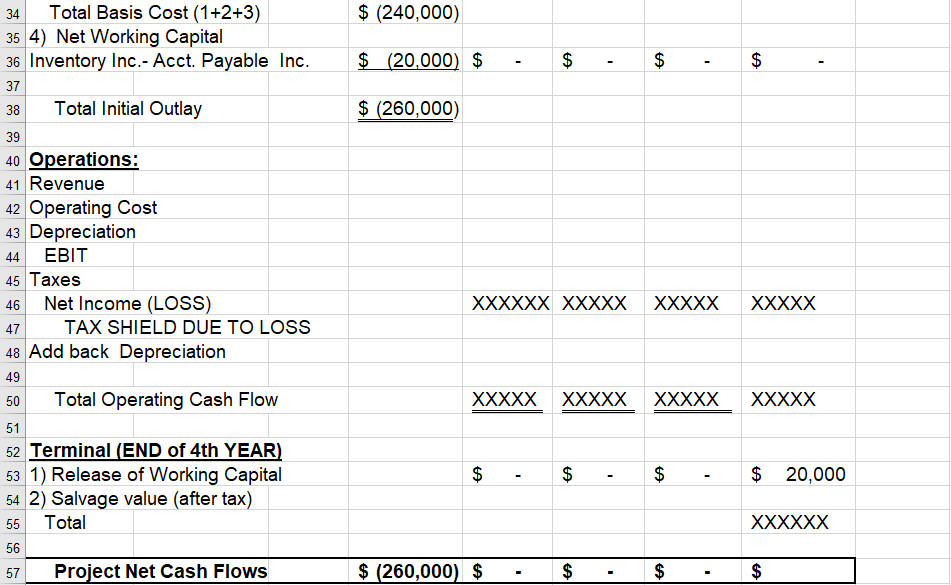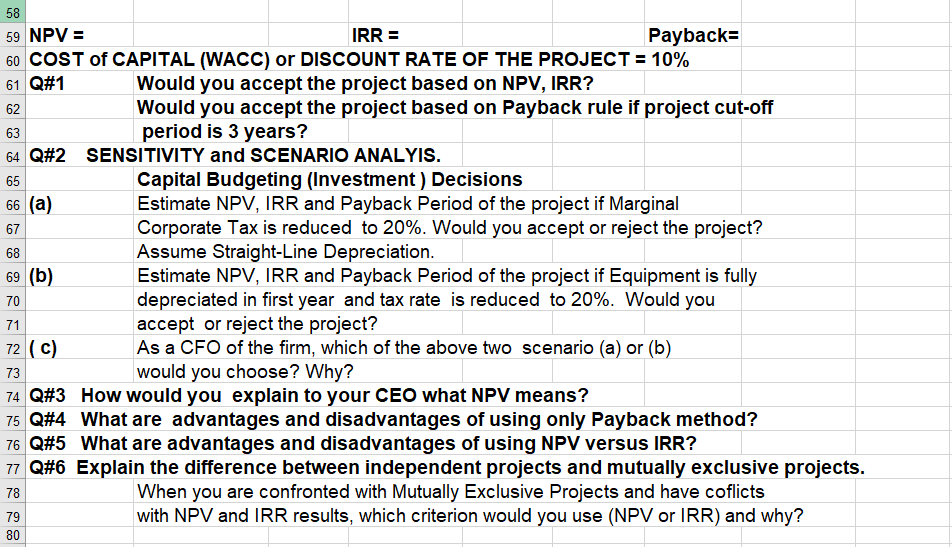


B H E F G 10 1. Learning Objectives 11 (a) Develop proforma Project Income Statement Using Excel Spreadsheet 12 (b) Compute Net Project Cash flows, NPV, IRR and PayBack Period 13 (c) Develop Problem-solving and Critical Thinking Skills 14 15 16 1) Life Period of the Equipment = 4 years 8) Sales for first year (1) $ 200,000 17 2) New equipment cost $ (200,000) 9) Sales increase per year 5% 18 3) Equipment ship & install cost $ (35,000) 10) Operating cost: $ (120,000) 19 4) Related start up cost $ (5,000) (60 Percent of Sa -60% 20 5) Inventory increase $ 25,000 11) Depreciation (Straight Line $ 160,000) 21 6) Accounts Payable increase $ 5,000 12) Tax rate 35% 227) Equip. Salvage Value Estimated $ 15,000 13) Cost of Capital (WACC) 10% 23 End of Yeai (fully depreciated) 24 25 26 ESTIMATING Initial Outlay (Cash Flow, CFO, T= 0) 27 28 YEAR CFO CF1 CF2 CF3 CF4 29 0 1 2 3 4 30 Investments: 31 1) Equipment cost $ (200,000) 32 2) Shipping and Install cost $ (35,000) 33 3) Start up expenses $ (5,000) 19 $ (240,000) $ (20,000) $ $ $ $ $ $ (260,000) 34 Total Basis Cost (1+2+3) 354) Net Working Capital 36 Inventory Inc.- Acct. Payable Inc. 37 38 Total Initial Outlay 39 40 Operations: 41 Revenue 42 Operating Cost 43 Depreciation 44 EBIT 45 Taxes 46 Net Income (LOSS) 47 TAX SHIELD DUE TO LOSS 48 Add back Depreciation 49 50 Total Operating Cash Flow 51 52 Terminal (END of 4th YEAR) 53 1) Release of Working Capital 54 2) Salvage value (after tax) 55 Total 56 57 Project Net Cash Flows XXXXXX XXXXX XXXXX XXXXX XXXXX XXXXX XXXXX XXXXX $ $ $ - $ 20,000 XXXXXX $ (260,000 $ $ $ $ TA 58 59 NPV = IRR = Payback= 60 COST of CAPITAL (WACC) or DISCOUNT RATE OF THE PROJECT = 10% 61 Q#1 Would you accept the project based on NPV, IRR? 62 Would you accept the project based on Payback rule if project cut-off 63 period is 3 years? 64 Q#2 SENSITIVITY and SCENARIO ANALYIS. 65 Capital Budgeting (Investment) Decisions 66 (a) Estimate NPV, IRR and Payback period of the project if Marginal 67 Corporate Tax is reduced to 20%. Would you accept or reject the project? 68 Assume Straight-Line Depreciation. 69 (b) Estimate NPV, IRR and Payback period of the project if Equipment is fully 70 depreciated in first year and tax rate is reduced to 20%. Would you 71 accept or reject the project? 72 (C) As a CFO of the firm, which of the above two scenario (a) or (b) would you choose? Why? 74 Q#3 How would you explain to your CEO what NPV means? 75 Q#4 What are advantages and disadvantages of using only Payback method? 76 Q#5 What are advantages and disadvantages of using NPV versus IRR? 77 Q#6 Explain the difference between independent projects and mutually exclusive projects. When you are confronted with Mutually Exclusive Projects and have coflicts with NPV and IRR results, which criterion would you use (NPV or IRR) and why? 73 78 79 80 B H E F G 10 1. Learning Objectives 11 (a) Develop proforma Project Income Statement Using Excel Spreadsheet 12 (b) Compute Net Project Cash flows, NPV, IRR and PayBack Period 13 (c) Develop Problem-solving and Critical Thinking Skills 14 15 16 1) Life Period of the Equipment = 4 years 8) Sales for first year (1) $ 200,000 17 2) New equipment cost $ (200,000) 9) Sales increase per year 5% 18 3) Equipment ship & install cost $ (35,000) 10) Operating cost: $ (120,000) 19 4) Related start up cost $ (5,000) (60 Percent of Sa -60% 20 5) Inventory increase $ 25,000 11) Depreciation (Straight Line $ 160,000) 21 6) Accounts Payable increase $ 5,000 12) Tax rate 35% 227) Equip. Salvage Value Estimated $ 15,000 13) Cost of Capital (WACC) 10% 23 End of Yeai (fully depreciated) 24 25 26 ESTIMATING Initial Outlay (Cash Flow, CFO, T= 0) 27 28 YEAR CFO CF1 CF2 CF3 CF4 29 0 1 2 3 4 30 Investments: 31 1) Equipment cost $ (200,000) 32 2) Shipping and Install cost $ (35,000) 33 3) Start up expenses $ (5,000) 19 $ (240,000) $ (20,000) $ $ $ $ $ $ (260,000) 34 Total Basis Cost (1+2+3) 354) Net Working Capital 36 Inventory Inc.- Acct. Payable Inc. 37 38 Total Initial Outlay 39 40 Operations: 41 Revenue 42 Operating Cost 43 Depreciation 44 EBIT 45 Taxes 46 Net Income (LOSS) 47 TAX SHIELD DUE TO LOSS 48 Add back Depreciation 49 50 Total Operating Cash Flow 51 52 Terminal (END of 4th YEAR) 53 1) Release of Working Capital 54 2) Salvage value (after tax) 55 Total 56 57 Project Net Cash Flows XXXXXX XXXXX XXXXX XXXXX XXXXX XXXXX XXXXX XXXXX $ $ $ - $ 20,000 XXXXXX $ (260,000 $ $ $ $ TA 58 59 NPV = IRR = Payback= 60 COST of CAPITAL (WACC) or DISCOUNT RATE OF THE PROJECT = 10% 61 Q#1 Would you accept the project based on NPV, IRR? 62 Would you accept the project based on Payback rule if project cut-off 63 period is 3 years? 64 Q#2 SENSITIVITY and SCENARIO ANALYIS. 65 Capital Budgeting (Investment) Decisions 66 (a) Estimate NPV, IRR and Payback period of the project if Marginal 67 Corporate Tax is reduced to 20%. Would you accept or reject the project? 68 Assume Straight-Line Depreciation. 69 (b) Estimate NPV, IRR and Payback period of the project if Equipment is fully 70 depreciated in first year and tax rate is reduced to 20%. Would you 71 accept or reject the project? 72 (C) As a CFO of the firm, which of the above two scenario (a) or (b) would you choose? Why? 74 Q#3 How would you explain to your CEO what NPV means? 75 Q#4 What are advantages and disadvantages of using only Payback method? 76 Q#5 What are advantages and disadvantages of using NPV versus IRR? 77 Q#6 Explain the difference between independent projects and mutually exclusive projects. When you are confronted with Mutually Exclusive Projects and have coflicts with NPV and IRR results, which criterion would you use (NPV or IRR) and why? 73 78 79 80









